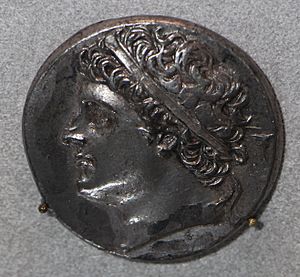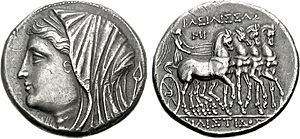Hiero II of Syracuse facts for kids
Hiero II (Greek: Ἱέρων Β΄) was a powerful Greek leader of Syracuse, a city in ancient Sicily, from about 275 BC to 215 BC. He was the son of a noble named Hierocles. Before becoming a ruler, Hiero was a general for Pyrrhus of Epirus, a famous king and military commander. Hiero II played an important part in the First Punic War, a big conflict between Rome and Carthage. He is also known for his connection to the famous thinker Archimedes and the story of "Eureka!"
Contents
Becoming a Leader
After King Pyrrhus left Sicily in 275 BC, the people and army of Syracuse chose Hiero to lead them. He made his position stronger by marrying the daughter of Leptines, a very important citizen.
At this time, a group of soldiers called the Mamertines had taken control of the city of Messina. These soldiers, who were originally from Campania, were causing trouble for Syracuse. Hiero led his army and defeated the Mamertines in a big battle near the Longanus river. He almost captured Messina, but the powerful city of Carthage stepped in and stopped him. Because of his success, the people of Syracuse made him their king in 275 BC.
The First Punic War
In 264 BC, Hiero attacked the Mamertines again. This time, the Mamertines asked Rome for help. Hiero quickly joined forces with Hanno, a Carthaginian leader who had just arrived in Sicily. They fought a battle against the Romans, led by a consul named Appius Claudius Caudex. The battle didn't have a clear winner, so Hiero decided to go back to Syracuse.
The Roman army then put pressure on Syracuse. In 263 BC, Hiero made a peace treaty with Rome. This agreement allowed him to rule over the southeastern part of Sicily and the eastern coast up to a place called Tauromenium.
After the War
From the time he made peace with Rome until his death in 215 BC, Hiero II remained a loyal friend to the Romans. He often helped them by sending soldiers and supplies during the Punic War.
Hiero also kept a strong fleet of ships to protect his lands. He asked his famous relative, Archimedes, to design powerful war machines. These machines later became very important during the Roman siege of Syracuse.
The "Eureka" Story
There's a famous story about Hiero II and Archimedes. Hiero had given a goldsmith some gold to make a special crown for a temple. He suspected that the goldsmith had cheated him by mixing cheaper silver with the gold. Hiero asked Archimedes to find out if the crown was pure gold.
According to the story, Archimedes was thinking about this problem while taking a bath. He noticed that the water level rose when he got into the tub. This made him realize that he could measure the volume of the crown by seeing how much water it displaced. He was so excited by this discovery that he supposedly jumped out of the bath and ran through Syracuse shouting "Eureka, eureka!" which means "I have found it!" in Greek.
The story says that Archimedes' method worked. He proved that the goldsmith had indeed used some silver instead of pure gold.
Legacy and Honors
The poet Theocritus, who was a favorite of Hiero, wrote about how prosperous Syracuse was during Hiero's rule.
Much later, in the 16th century, a famous writer named Machiavelli wrote a book called The Prince. In this book, Machiavelli praised Hiero II as a very good and strong leader. He saw Hiero as a rare example of someone who became a powerful ruler even though he wasn't born into royalty. Machiavelli compared Hiero to other great historical figures like Moses and Cyrus.
See also
 In Spanish: Hierón II para niños
In Spanish: Hierón II para niños




